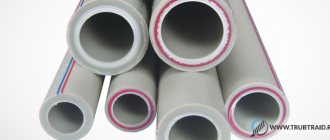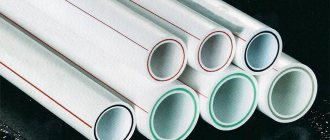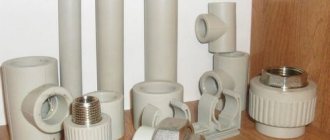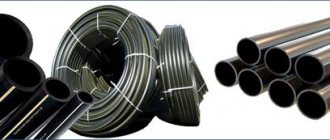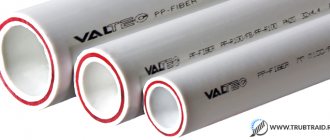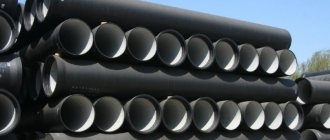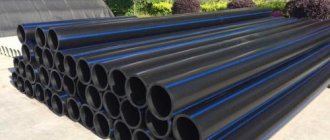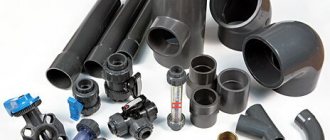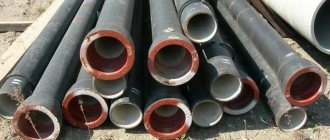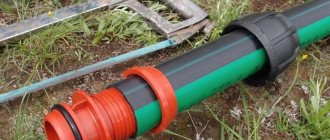They are installed in residential buildings and industrial buildings. Unlike options made of steel and cast iron, such materials are not destroyed by rust, and they can last more than 50 years.
Areas of application:
- Their distinctive characteristics and ease of installation make it possible to use them in the network for supplying drinking water.
- In agriculture.
- Pipes and fittings of this type are used for supplying cold and hot water, for installing “warm floors”, for branches in a centralized heating system, and for connecting radiators.
- Transportation of air and aggressive chemical media.
- For drainage and irrigation systems.
- This workpiece tolerates temperatures from -10 to 900C. And will withstand short-term surges up to 1100C.
- The melting point is +1490C.
- Thermal conductivity at 20 degrees – 0.24 W/mS.
IMPORTANT! Polypropylene pipes (the characteristics of experts confirm this) are classified as environmentally friendly substances; they are completely safe for technological use.
Main characteristics of polypropylene pipes
- Polypropylene pipes for cold and hot water supply, heating and ventilation have become popular and widely used due to their advantages:
- Standardized and predictable service life. Exceeds the same indicator for metal communications several times;
- Smooth inner surface reduces pressure loss. Consequently, energy costs for pumping liquids are reduced by 10-15%. And if steel pipelines are “overgrown,” then up to 40%.
- Plastic is an energy-saving solution; The smooth outer surface is not susceptible to corrosion, does not require painting and maintenance, therefore, reduces operating costs for preventive and routine repairs by 3-5%;
- Low electrical conductivity – reduces the likelihood of injury from stray electric currents. It is possible to lay pipelines near power cables of electric transport substations without installing enhanced anti-corrosion insulation and cathodic protection, which reduces the cost of pipelines by 5+7%;
- Low sound conductivity allows, without violating sanitary and hygienic standards, to increase the fluid flow rate to 6-9 m/s (steel 3 m/s), which allows increasing the throughput of pipes by 2-3 times and reducing the material consumption of systems, due to the diameter of the pipelines used ;
- Polypropylene pipes have proven themselves well when installed in winter due to their high elasticity. This property reduces the magnitude of hydraulic shocks. It is possible to freeze liquids in the pipeline without destroying the walls;
- The low thermal conductivity of the material reduces the likelihood of condensation and reduces the thickness of the required thermal insulation. This reduces capital costs by up to 3% compared to metal pipelines;
- Low weight 7-8 times less than that of metal, reduces transport and storage costs;
- Welded connections are highly reliable, and a wide range of fittings allows you to install systems of varying complexity;
- Low mechanical strength. Reduces labor costs and increases productivity by 2+4 times when carrying out procurement and installation work;
- Fire safety of installation processes. Allows you to carry out work on existing facilities and in old reconstructed buildings;
- Low energy consumption and simplicity of installation tools make it possible to work at sites with limited power supply and in field conditions.
- Low cost – high efficiency.
Types of fittings
A fitting for polypropylene pipes is a connecting element also made of polypropylene. May have a nickel-plated brass pressed insert with thread. The following connecting parts are used for the installation of pipelines:
- coupling - a hollow element similar to a miniature barrel for welding pipes of the same cross-section. Pipes are inserted from both sides;
- adapter - a similar element, but for connecting pipes with different diameters. There are also adapters for connecting plastic pipes with metal pipes, with threads at one end;
- the corner is used to turn the highway: this way you can avoid unnecessary bending. There are angles at 45 and 90 degrees, as well as those combined with adapters - with different cross-sections of inlet holes, with metal threads on one side;
- tees and crosses are used to connect more than two pipes. The angles and configuration are different, there are parts with and without threads;
- bypasses - parts for bypassing structural elements (for example, other pipes). Allows you to avoid unnecessary bending of polypropylene. Shapes and sizes vary;
- compensators. They exist in finished form, but if necessary, can be assembled from fragments of pipes and corners;
- American - dismountable fitting, coupling with union nut. In those areas that will be periodically dismantled (to clean the unit, install a water meter, etc.), it is preferable to install an American one.
In addition to connecting parts, the pipelines use faucets and valves made of polypropylene, plugs (to cover blind end sections), fasteners and clamps for mounting on walls.
Various fittings for polypropylene pipes
Types of raw materials used for the manufacture of polypropylene pipes
Polypropylene pipes for cold water supply, hot water and heating differ from their brothers and sisters used for internal and external sewerage. No, not by appearance, but by the raw materials from which they are made. The raw materials will endow the pipes with certain characteristics and properties.
A brief classification of it will help in choosing products made from it and will simplify the choice. Raw materials used for the production of polypropylene pipes:
- Type 1 (PPH) is made from a special type of polymer - homopolypropylene. Type 1 pipes are used for industrial water pipelines, ventilation systems, and sewerage;
- Type 2 (PPV) is made from polypropylene block copolymer. This is the most common pipe for external sewage systems. It is not trusted for any other uses. Therefore, forget about: underfloor heating systems, cold water supply and hot water systems;
- Type 3 (PPR) – random copolymer of polypropylene. The most common material for the manufacture of hot and cold water supply and heating pipelines is made of polypropylene.
Separately, it is worth paying attention to a separate type of raw material used - PP-RCT or BETA PP-R - this material has increased resistance to high temperatures with high heat resistance.
Such products allow you to transport the working environment up to +110°C. Please note: pipes and fittings made from all types of polypropylene, as well as plastic systems in general without special additives, are prohibited for installation in open areas. Since they do not have UV protection.
Where is polypropylene pipe with nominal pressure PN10, PN20 used?
These products belong to the group of plastic pipes. The polypropylene from which the pipe is made is produced by polymerization with the participation of catalysts made of metal complex materials. Enterprises producing polypropylene pipes produce two main types of products: those designed for a pressure of 10 bar - propylene pipe PPRC PN10 (today the abbreviation is more often used - propylene pipe PPR PN10), and also for a pressure of 20 bar - polypropylene pipe PPRC PN20 (PPR PN20) .
Propylene pipe PPR PN10 is used in systems with low pressure, so its walls are thinner and the price is correspondingly lower. Tests, however, have shown that the PPR PN10 propylene pipe will not collapse when the pressure increases abruptly to 30 bar. The connection of such pipes to each other (welding or soldering) is carried out using polypropylene fittings using a special apparatus.
The process is simple, but requires strict adherence to technology. The device is heated to a temperature of about +300 °C, the pipe and fitting are inserted into metal mandrels heated on the device and softened. Then the heated parts are quickly connected, and after a few seconds required for the connection to cool, an even and reliable seam is obtained, which in its strength is in no way inferior to a monolithic propylene structure.
PPR PN10 polypropylene pipes have thin walls that will bend when heated, so they are not used when organizing hot water supply. For this purpose, mainly reinforced pipes are used, which are able to withstand higher temperatures.
Polypropylene pipes have one property that makes them indispensable in areas with cold climates: in the event of an emergency freezing of the water inside, they do not burst, and when the situation arises is eliminated, they resume their function without additional restoration measures. That is why such pipes are especially convenient to operate in places where accidents are possible.
Read material on the topic: Accessories for polypropylene pipes
Marking of PPR pipes
According to GOST R 53630-2015, pipe marking consists of:
- manufacturer's name or trademark;
- abbreviated designation of material;
- standard dimensional ratio SDR (S series);
- nominal outer diameter;
- nominal pipe wall thickness in millimeters;
- operating class;
- maximum operating pressure corresponding to the operating class in MPa;
- number of the standard according to which the pipe is manufactured.
An example of a symbol for a 3-layer pipe with a middle layer of glass-filled polypropylene with a nominal outer diameter of 20 mm, a nominal wall thickness of 3.4 mm:
SLT AQUA PP-R/PP-R-GF/PP-R PN25/SDR6 20×3.4 class 1/1.0 MPa class 2/0.8 MPa class 4/1.0 MPa class 5/0.6 MPa GOST R 53630- 2015 “date” “time” “batch number”
- SLT AQUA – name of the manufacturer;
- PP-R – the material from which the pipe is made (in this case, random copolymer);
- PN25 – nominal maximum excess pressure at 20 °C;
- SDR6 – dimensional ratio of pipe diameter to wall thickness. (20:1,9);
- 20×3.4 – diameter x wall thickness (nominal values); class 1/1.0 MPa – hot water supply at 60 °C;
- class 2/0.8 MPa - hot water supply at 70 °C;
- class 4/1.0 MPa – low-temperature heating with heating devices;
- GOST R 53630-2015 – reference to GOST, which the manufacturer adheres to;
- 11/15/2017 12:53 – date and time of manufacture (dynamic components);
- batch 11-18-000 – batch number to which the product is linked for further tracking and certification of the product.
Production of polypropylene pipes
Briefly - how the production process occurs. Let's say it easily - you won't believe it. Yes, special machines are used for this - extruders. The granules are poured into silos or bunkers. Then they are pumped into the machine using pneumatics. There it is heated and the auger mixes the material for uniformity. At the output there are calibrators and pulling devices. Calibrator – adjusts the diameter and wall thickness. The pulling device pulls out the finished pipe. The pipe is then cooled in special baths and cut to the specified size.
Fittings are produced using a similar technology, but using thermoplastic machines. For production, you must have a machine and a mold that determines the type and appearance of the part. The raw material, heated to the required temperature, is fed into the mold under pressure, filling it. The part is then cooled and the finished products are ejected from it. The process is then repeated over and over again.
Connection Features
Three types of welding are used to connect polypropylene pipe sections:
- end-to-end;
- polyfuse (bell-shaped);
- using electrical fittings.
When connecting to metal pipes, fittings with threaded inserts are used. Teflon tape and other sealants are used to seal joints.
Important: You cannot cut threads on factory products yourself. For installation, you should use fittings and pipes of the same brand; this is the only way to guarantee the quality of the finished system.
Several basic rules for installing a sub-pipeline:
- Before starting work, you need to carefully inspect the material to avoid damage and contamination.
- Installation should be carried out at a positive temperature of 5 degrees, if necessary, bend pipes - from 15.
- The maximum bending radius depends on the size of the pipes. For example, for 1.6-3.2 cm - 8 diameters.
- Fastening is carried out taking into account thermal expansion. When heated, the pipe becomes deformed and may burst. Installation on a fixed support is only permitted for a short distance. In all other cases, a movable one is used, allowing for the possibility of compensatory displacement without deviation from the axis of the pipeline.
- The required slope of the pipe is from 0.5 percent towards draining the coolant or water using a drain tap.
- Wall bends are mounted on a rigid plate to eliminate torsional stress.
In domestic conditions, polypropylene pipes are connected using socket welding
Standard sizes and types of ppr pipes
Knowing the main standard sizes, you can easily determine which system they are suitable for.
- PN10 (SDR11) - pipes designed for pressure up to 1.53 MPa, at a temperature not exceeding 20° C. Outer diameters 20-110 mm and walls 1.9-10 mm. Application – cold water supply and air conditioning.
- PN16 (SDR7.4) – permissible pressure up to 2.46 MPa, at a temperature not exceeding 20° C. Details can be found in the table, and depending on the temperature of the coolant. This type is rarely used, as its characteristics are similar to the SDR6 (PN20) pipe. And the timidity of installers (they think that it will not withstand the required loads) and its inaccessibility to the general public reduce its use. Can be used for coolant with temperatures up to +60° C. Diameters - 20-110 mm, walls 2.8-15.1 mm. Application – cold and hot water supply, air conditioning.
- PN20 (SDR6) is a grade designed for pressures up to 2 MPa and temperatures up to +80° C. This is not so. Pressure up to 3.06 MPa and temperature up to 95° C. Diameters - 20-110 mm, walls 3.4 - 18.3 mm. Application – any system where the temperature and pressure do not exceed the maximum values.
- PN25 (SDR6) - this marking is used for pipes with reinforcement to emphasize their increased characteristics, but this is not so! Reinforcement does not provide any technical advantages other than reducing linear expansion. Pressure up to 3.06 MPa and temperature up to +95° C. Diameters - 20 - 110, walls - 3.4 - 18.3 mm. Application: any system where temperature and pressure do not exceed maximum values.
Types of reinforcement for polypropylene pipes
In addition to dividing pipes by wall thickness, it is reasonable to divide them into reinforced and non-reinforced or single-layer and multi-layer. When deciding which polypropylene pipes to use where, it should be taken into account that multilayer products are made from the same materials described above, but have additional reinforcement, which definitely affects their characteristics. The main one is linear expansion.
By design, reinforced pipes differ according to the reinforcement scheme:
- The most common is reinforcement with glass fiber or basalt fiber. This is when a poorly expanding substance is mixed with the feedstock and introduced into the pipe, forming a monolithic structure.
- The second option is reinforcement with an aluminum layer. For this purpose, smooth or perforated aluminum is used.
Any reinforcement reduces the coefficient of linear expansion and simplifies design and installation. But there are installation features that you need to know about:
- Working with a pipe reinforced with aluminum on top is more difficult, since it requires preliminary cleaning of the pipes at the junction with the fittings.
- Assembly of fiberglass and composite pipe systems is simpler since stripping is not required.
- Remember - reinforcement reduces the coefficient of linear expansion, i.e. inhibits uncontrolled elongation of the pipe with increasing temperature. This layer has no other functionality!
- It is impossible to completely get rid of the influence of linear expansions - even a steel pipe requires compensation on the DHW and Heating risers.
Material Research
In the process of polypropylene evolution, more and more new materials appeared. At the very beginning, the propylene homopolymer PPH was announced, then the block copolymer PPB. One of the latest developments by chemists is Poly Propylene Random Copolymer (PPRC), which translated means a static copolymer of propylene with ethylene. Therefore, a new acquaintance is an ordinary polypropylene pipe (PPR). How do the technical characteristics of PPRC pipes differ from conventional polypropylene?
The answer is quite simple: nothing. The pipes are made of the same material, they just shortened the abbreviation by one letter.
Here and there you can find another name for polypropylene pipe – PPRS pipe. However, do not be alarmed, this is not a new material, but ordinary polypropylene.
